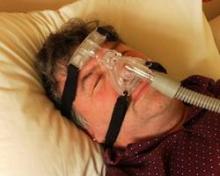Continuous positive airway pressure therapy was linked to a lower rate of incident hypertension in one study but not in another, separate study reported online in the May 23/30 issue of JAMA.
However, the investigators in the second study discovered methodologic flaws that called their conclusion into question. They performed a post hoc analysis, and the results were similar to those of the first study: CPAP therapy, when adhered to, is associated with a lower rate of incident hypertension.
Neither study could definitively establish that CPAP itself decreases hypertension; both could only note the strong association between the treatment and a decreased rate of the disorder.
CPAP therapy is known to decrease overall cardiovascular risk and to lower blood pressure in certain groups of patients, but its efficacy in preventing the onset of hypertension has not been adequately studied to date, both groups of researchers noted.
In the first study, Dr. Jose M. Marin of Miguel Servet University Hospital, Zaragoza (Spain), and his associates used data from the observational Zaragoza Sleep Cohort Study to assess whether patients on long-term CPAP were less likely to develop hypertension. The cohort study involved more than 5,000 patients referred by their primary care physicians to a sleep center for assessment of sleep-disordered breathing in 1994-2000.
For his analysis, Dr. Marin and his colleagues studied 1,889 such patients who had no hypertension at baseline and who underwent overnight sleep studies to ascertain the cause of their snoring, daytime fatigue, or daytime sleepiness. A total of 824 subjects were found to have obstructive sleep apnea and then adhered to CPAP therapy; another 462 were found to have obstructive sleep apnea but were ineligible for CPAP, 195 declined to try CPAP, and 98 were nonadherent with CPAP therapy. Another 310 patients who were not found to have obstructive sleep apnea served as control subjects.
During a mean follow-up of 11 years, 705 patients developed incident hypertension.
In unadjusted analyses, the rate of new-onset HT was 3.06 per 100 person-years among patients who adhered to CPAP therapy. It was significantly higher in patients who were ineligible for CPAP (3.34 per 100 person-years), and dramatically higher those who declined CPAP (5.84 per 100 person-years) and those who were nonadherent (5.12 per 100 person-years).
After the data were adjusted to account for several confounders, the risk of new-onset HT was the same between patients who adhered to CPAP and control subjects, but was significantly higher in all other groups (JAMA 2012;307:2169-76).
These findings were independent of the severity of obstructive sleep apnea and of patients’ body mass index. Since almost all the subjects gained weight during follow-up, this suggests that weight gain does not diminish the protective association of CPAP therapy and the development of HT, Dr. Marin and his associates said.
Overall, the study results suggest that obstructive sleep apnea is a modifiable risk factor for new-onset HT. This is highly relevant to clinicians "considering that obstructive sleep apnea, despite a high prevalence in Western populations, remains overwhelmingly unrecognized and untreated," they added.
In the second study, Dr. Ferran Barbe of Arnau de Vilanova University Hospital, Lleida (Spain), and his associates assessed CPAP’s effect on incident hypertension among subjects who had obstructive sleep apnea but did not have symptoms of daytime sleepiness or fatigue. This is a subgroup of apnea patients who have not been shown to benefit from the treatment, with the caveat that research in this patient population has been inadequate.
Dr. Barbe and his colleagues assessed 723 such patients who were randomly assigned to receive CPAP (357 subjects) or no CPAP (366 control subjects). During a median follow-up of 4 years, 147 patients developed incident hypertension and 59 had cardiovascular events.
In the CPAP group there were 68 cases of HT and 28 CV events, and in the control group there were 79 cases of HT and 31 CV events – a nonsignificant difference.
The rate of combined HT/CV events was 11.02 per 100 person-years with CPAP and 9.20 per 100 person-years without CPAP, also a nonsignificant difference. Apnea severity did not affect these findings.
The researchers noted that they had assessed patients who had been prescribed CPAP but not patients who had adhered to CPAP therapy, and that adherence – use of the treatment for at least 4 hours per night – is critical to CPAP’s effectiveness. They therefore performed a post hoc analysis based on a cutoff of 4 hours of actual adherence to CPAP, which they substantiated by examining oxygen saturation data.


